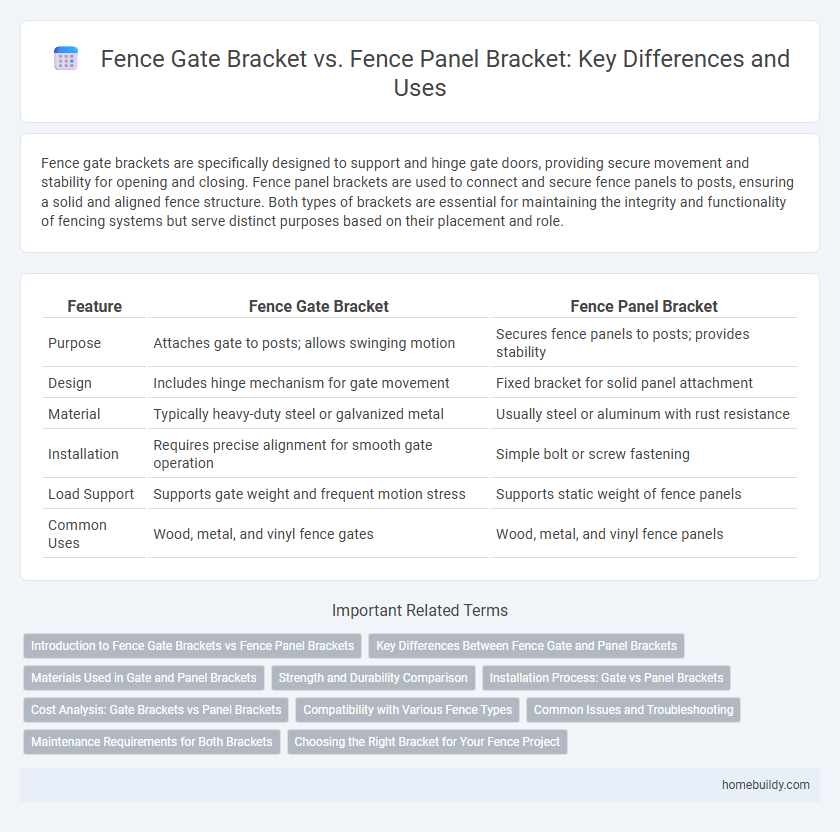Fence gate brackets are specifically designed to support and hinge gate doors, providing secure movement and stability for opening and closing. Fence panel brackets are used to connect and secure fence panels to posts, ensuring a solid and aligned fence structure. Both types of brackets are essential for maintaining the integrity and functionality of fencing systems but serve distinct purposes based on their placement and role.
Table of Comparison
| Feature | Fence Gate Bracket | Fence Panel Bracket |
|---|---|---|
| Purpose | Attaches gate to posts; allows swinging motion | Secures fence panels to posts; provides stability |
| Design | Includes hinge mechanism for gate movement | Fixed bracket for solid panel attachment |
| Material | Typically heavy-duty steel or galvanized metal | Usually steel or aluminum with rust resistance |
| Installation | Requires precise alignment for smooth gate operation | Simple bolt or screw fastening |
| Load Support | Supports gate weight and frequent motion stress | Supports static weight of fence panels |
| Common Uses | Wood, metal, and vinyl fence gates | Wood, metal, and vinyl fence panels |
Introduction to Fence Gate Brackets vs Fence Panel Brackets
Fence gate brackets provide robust support by securely attaching gates to fence posts, allowing smooth opening and closing motions, while fence panel brackets are designed to connect and stabilize fence panels between posts for consistent fencing alignment. Gate brackets typically feature adjustable hinges and heavy-duty materials to withstand frequent movement and weight, whereas panel brackets focus on rigidity and ease of installation to maintain fence line integrity. Understanding the distinct functions and structural requirements of gate brackets versus panel brackets is essential for optimal fence construction and durability.
Key Differences Between Fence Gate and Panel Brackets
Fence gate brackets are designed to support the movement and weight of swinging gates, featuring robust hinge points for smooth opening and closing. Fence panel brackets primarily secure stationary fence panels to posts, emphasizing stability and alignment without allowing movement. The key difference lies in functionality: gate brackets accommodate motion while panel brackets maintain fixed positions.
Materials Used in Gate and Panel Brackets
Fence gate brackets are typically constructed from heavy-duty steel or galvanized iron to support the weight and frequent movement of gates, ensuring durability and resistance to rust and corrosion. Fence panel brackets, by contrast, often use lighter materials such as aluminum or powder-coated steel, optimized for securing stationary panels while preventing weather-related damage. Both bracket types employ protective coatings like zinc plating or powder coating to extend lifespan and maintain structural integrity in various outdoor conditions.
Strength and Durability Comparison
Fence gate brackets are engineered to provide robust support for the dynamic stress of swinging gates, offering higher strength and enhanced durability through reinforced steel construction and corrosion-resistant coatings. Fence panel brackets, designed primarily for static support, tend to prioritize stability and alignment over heavy load-bearing capacity, often using lighter materials with moderate resistance to weathering. When comparing strength and durability, gate brackets outperform panel brackets in handling mechanical strain and environmental exposure, making them essential for functional gate applications requiring long-lasting performance.
Installation Process: Gate vs Panel Brackets
Fence gate brackets require precise alignment with the gate posts to ensure smooth swinging and secure attachment, often involving heavy-duty screws or bolts for stability. Fence panel brackets typically attach directly to fence posts and support beams, using simpler installation methods like nails or lighter screws, as they only need to hold the panels in place without movement. Proper selection and installation of each bracket type are essential to maintain fence durability and functionality.
Cost Analysis: Gate Brackets vs Panel Brackets
Fence gate brackets typically cost more than fence panel brackets due to their reinforced construction designed to support gate weight and frequent movement. Panel brackets are generally simpler and less expensive since they only secure static fence panels, requiring fewer materials and less labor for installation. Choosing between gate and panel brackets involves balancing the higher upfront cost of gate brackets with their durability and function versus the budget-friendly, limited-use panel brackets.
Compatibility with Various Fence Types
Fence gate brackets are specifically designed to support the weight and movement of swinging or sliding gates, featuring heavy-duty construction compatible with wood, metal, and vinyl gates. Fence panel brackets, on the other hand, provide secure attachment points for stationary fence panels, offering versatile compatibility with chain link, wood, vinyl, and ornamental iron fences. Choosing the appropriate bracket ensures optimal stability and longevity based on the specific fence type and function.
Common Issues and Troubleshooting
Fence gate brackets often face alignment problems and sagging due to the weight and frequent movement of the gate, requiring regular tightening and sometimes shimming for proper operation. Fence panel brackets commonly experience loosening over time, leading to unstable panels that may need re-securing with screws or fasteners to maintain structural integrity. Both types benefit from rust-resistant coatings and periodic inspections to prevent deterioration and ensure long-lasting performance.
Maintenance Requirements for Both Brackets
Fence gate brackets typically require more frequent maintenance due to the constant movement and weight they support, which can cause wear on hinges and fasteners. Fence panel brackets generally experience less stress and thus require less frequent upkeep, primarily involving inspection for corrosion or loosening. Proper lubrication and timely tightening of gate brackets extend their lifespan, while regular checks on panel brackets prevent structural weaknesses.
Choosing the Right Bracket for Your Fence Project
Fence gate brackets are designed to support heavier loads and allow for smooth swinging motion, featuring hinges or pivot points for gate functionality. Fence panel brackets, on the other hand, provide stable attachment for fixed panels, ensuring rigidity and alignment without movement. Selecting the right bracket depends on whether you need mobility for gates or solid, immobile connections for fence panels, impacting durability and overall fence performance.
Fence gate bracket vs Fence panel bracket Infographic

 homebuildy.com
homebuildy.com